Best Shoulder Band Stretches for Shoulder Pain
Author:
Unlock your full potential by engaging with our experts and community! Have questions about your fitness journey or looking for expert advice on weightlifting techniques? Don’t hesitate — leave a comment below and Zinaida Bondarenko will provide a personalized answer and insights to help you reach your goals.
Torokhtiy is reader-supported. Some links are affiliate links, and we may earn a commission at no extra cost to you. See our disclosure page for details.
Shoulder injuries influence our daily activity, namely performing different exercises that engage the shoulder rotator cuff. Shoulder band stretches facilitate your fitness routine if you have shoulder pain or are recovering from injury.
Resistance band exercises will promote shoulder stability, flexibility, and strength, allowing more controlled motion without shoulder overload.
The feeling of tightness and stiffness may cause discomfort and limit the range of motion. That’s why shoulder band stretches can relieve tension in muscles, prevent pain, and tightness in the neck and shoulders. Neck stretching, shoulder rolling, and practicing yoga can reduce stiffness and increase flexibility in this area.
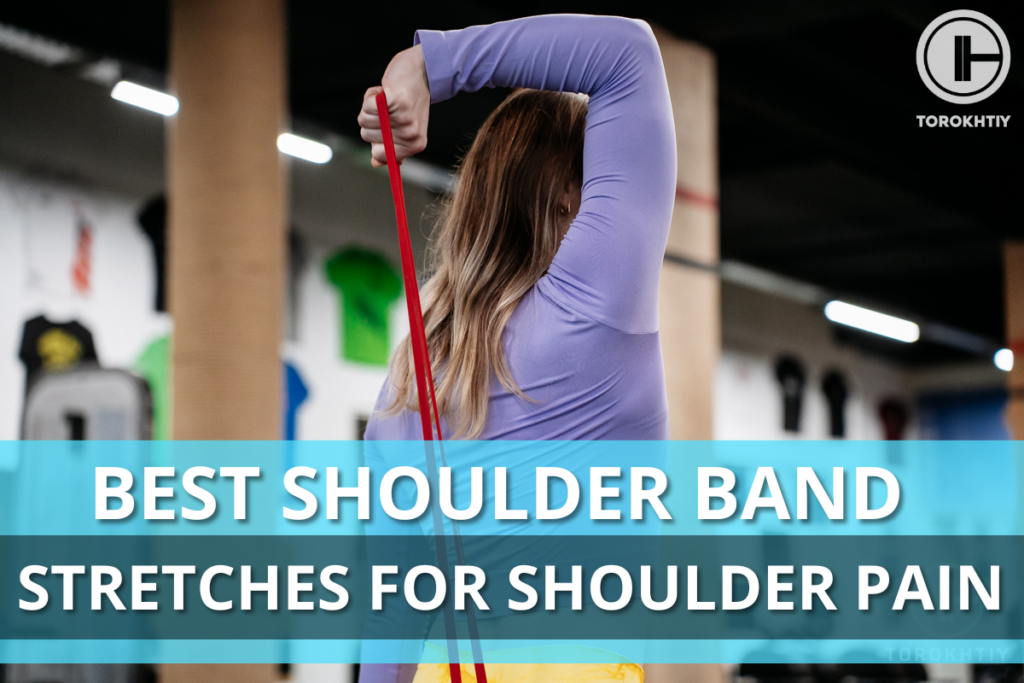
5 Shoulder band stretches benefits
Your shoulders are the joints that unite the upper arm bones (humerus), shoulder blades (scapula), and collarbone (clavicle). Each shoulder is supported by a group of four muscles and tendons, known as a rotator cuff. It covers and protects the upper arm bones, and helps you to raise and move your arm.
Pain in your shoulder can have various causes. It can be injured in a fall or accident, or because of overdoing some movement or activity. There are other reasons for such a condition. Tight shoulders can result from improper posture, sitting for long periods, carrying heavy bags, injury, and arthritis.
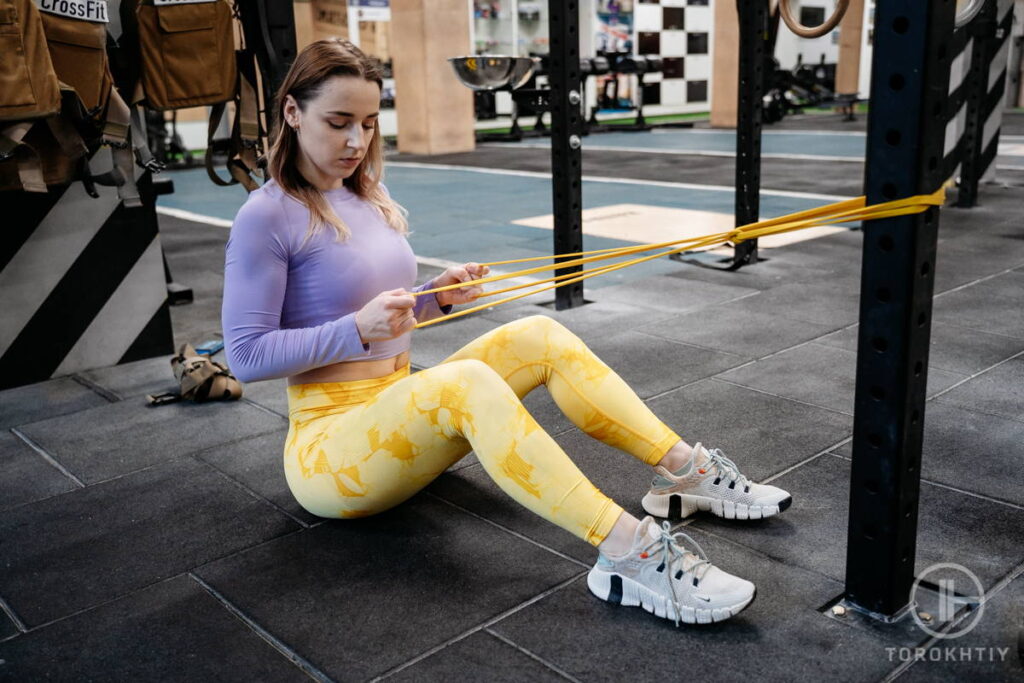
It can even derive from problems in other parts of your body, which is called referred pain. Shoulder band stretches have numerous potential health benefits. Thus, a resistance band may become the simplest way to do rotator cuff resistance band exercises for your shoulders without leaving your house:
✅ It’s a Low-Impact Exercise
Band stretches for shoulders are ideal if this area is prone to injury. Without gravity’s influence, you can manage and apply resistance of any tension, enabling you to focus on specific areas and rotation degrees.
Moreover, this training tool comes with different resistance, so it’s possible to choose the band concerning your fitness goals. With gentle movement, you’ll build shoulder strength, stability, and mobility by maintaining overall shoulder health and preventing injury.
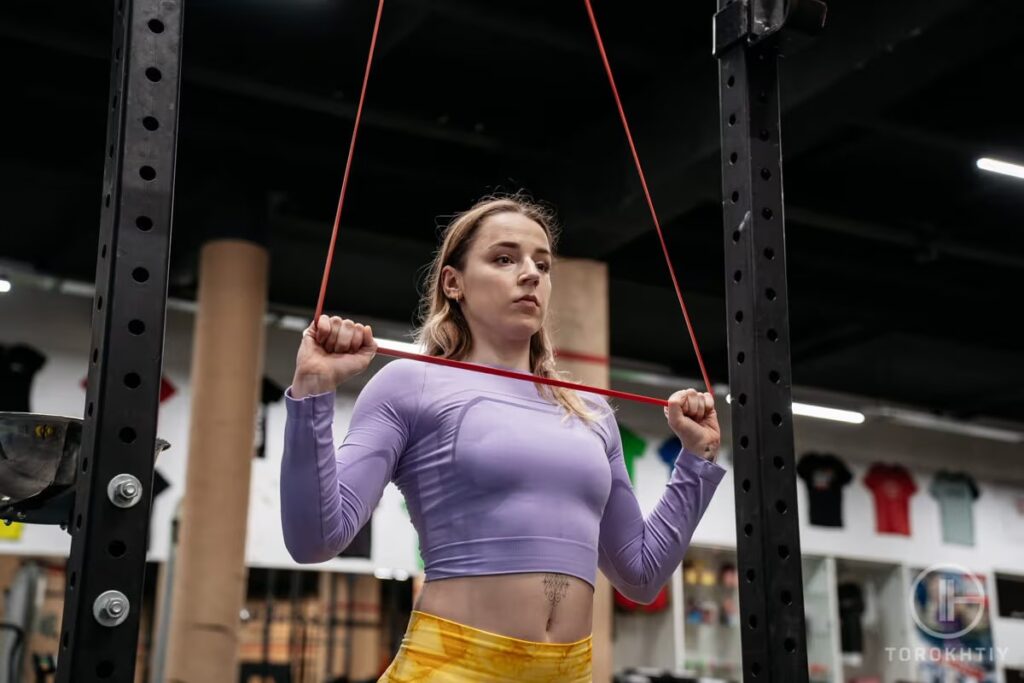
Resistance training exercises involving elastic bands have become increasingly interesting because they allow functional movement patterns and are more adaptable and accessible for individuals of various ages.
It’s possible to control exercise intensity by using different color codes or dimensions and forces of the elastic bands. Using elastic bands is effective for improving flexibility, balance, muscle strength, and functional capacity among older adults.
✅ Developing Strength and Resilience in the Rotator Cuff Muscles
Like conventional shoulder strengthening exercises, e.g., bench presses, overhead presses, and bicep curls, band shoulder stretch is effective in keeping the shoulder joint strong and healthy.
Additionally, they work to strengthen smaller, stabilizer muscles like the rotator cuff. Elastic band exercises are generally effective at improving and maintaining musculoskeletal function in older adults, as well as improving shoulder function and effecting separately on joints.
✅ Effective for Shoulder Rehab
If you have a rotator cuff strain or a tear, or even shoulder arthritis, you can include resistance bands for shoulder rehab exercises. Since this fitness tool doesn’t require you to put your shoulder muscles through their entire range of motion.
✅ Improving Posture
When strengthening the muscles surrounding the shoulder blades, which are engaged during band shoulder exercises, contributes to better posture and mitigates back discomfort.
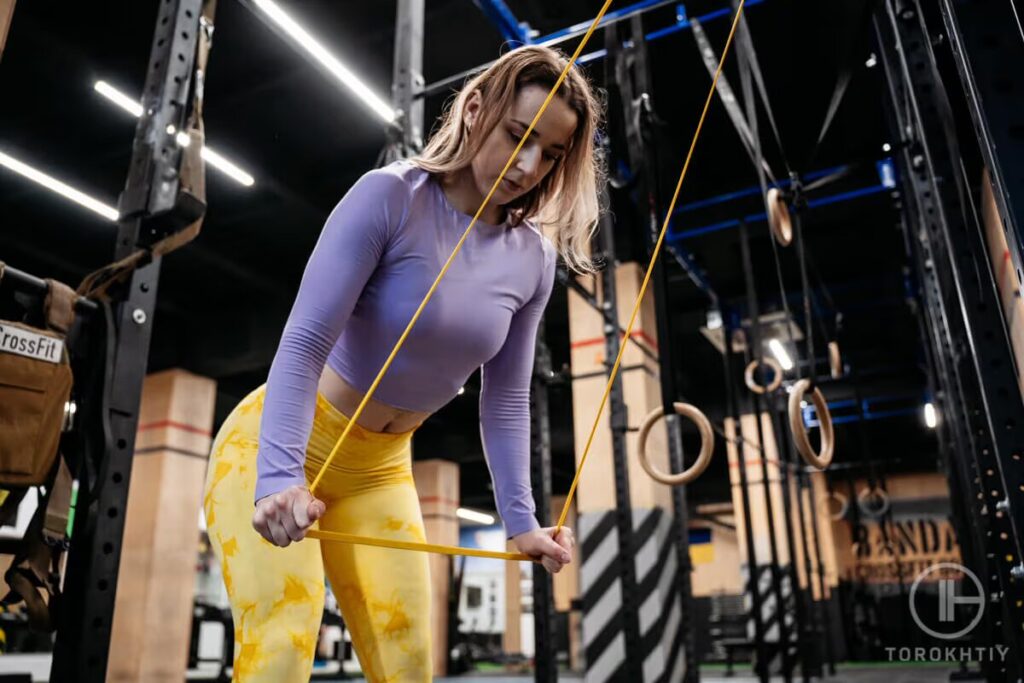
The study showed the enhancement of muscle strength and balance of the flexor, extensor, and horizontal abductor muscles via performing stabilization and stretching exercises. As a result, the improved muscular strength and balance would reduce the RSP features (rounded shoulder posture).
✅ Increasing Muscle Endurance & Versatility
Regular shoulder training with resistance bands can boost muscular endurance. This means you’ll be able to perform better daily tasks and other physical activities. Additionally, this fitness gear allows for a full range of motion, by engaging different muscle groups simultaneously.
4 Top exercises for a shoulder stretch
Indeed, the resistance band is a universal and simple fitness tool that is highly portable, convenient, and inexpensive, so everyone can incorporate it into their training routine.
The research indicated that the selection of an exercise type (e.g. resistance exercise, motor control exercise, and stretching exercise) cann help individuals with the RCRSP (rotator cuff-related shoulder pain) poses.
The following band rotator cuff exercises will facilitate shoulder mobility and also work out some other muscles responsible for stability in the rotator cuff.
1. Front Raise
The front raise exercise became forgotten and underestimated by many athletes, at the same time it’s overshadowed by other movements like overhead presses and lateral raises. Although, this exercise can be essential to your shoulder routine if done with proper technique.
Here’s a short overview of how to perform the exercise:
- Stand at the center of the resistance band with your feet shoulder-width, and slightly bend your knees.
- Grasp the band with an overhand grip when your palms are facing down to get into the starting position.
- Stand up with your chest up, keeping your upper back tight and abs braced. Keep your head neutral with your chin tucked.
- Move your hands upward simultaneously by lifting both arms in front of you. You can bend your elbows slightly but continue to keep your arms as straight as possible. In such a position, your palms will face the floor.
- Raise hands to the chin level, or slightly below. Then pause for a second before lowering them back to the starting position.
2. Lateral Raises
Including lateral raises with resistance bands several times a week can bring great results. This exercise primarily targets the lateral deltoids that are located on the sides of the shoulders.
Lateral raises also engage the anterior deltoids, which are in front of the shoulders, the posterior deltoids which are rear of the shoulders, and less the upper trap muscles.
So, incorporate lateral raises with resistance bands into your training and you’ll strengthen and develop your shoulder muscles and gain a more aesthetic physique.
The proper technique for performing banded lateral raises is to stand in the middle of a resistance band and raise arms to shoulder height against the band resistance. You should keep your elbows slightly bent. Here’s a step-by-step guide on how to perform this movement:
- Stand with your feet shoulder-width apart and place the resistance band under both feet.
- Grasp the band handles with your palms facing inwards, making your arms to hang naturally by your sides.
- Engage your core and keep a straight posture throughout the movement.
- Keep elbows slightly bent, by simultaneously raising both arms till the shoulder level, with your palms facing the floor.
- Make a pause for a second t at the top of the movement, ensuring you squeeze the shoulder blades together.
- Lower your arms back down gradually to the starting position by controlling each movement.
3. Reverse Fly
Reverse fly with resistance bands involves the posterior deltoids (rear shoulder muscles). This exercise actually mimics the exact function of the rear shoulder and places it against linear progressive resistance.
So, you will get the right amount of resistance at the exact right time during your reps. Follow this instruction on how to execute this exercise:
- Secure the band to the door with the door anchor at chest height.
- Grip a band handle in each hand and stand several feet away from the door while facing it. Keep your chest up, head straight, with your legs slightly bent. Your arms should be straight, with elbows at shoulder height and palms facing in.
- Pull the handles back and around, moving your arms from out in front of your body to directly out to the side.
- Keep your elbows slightly bent as you pull the resistance band back.
Another movement variation is stepping on the resistance band and moving your hands up and down:
- Step on the middle of the resistant band and bend your hips forward at a 45-degree angle.
- Hold the band handles with your opposite arms extended in front of you.
- Engaging your core, open your arms wide, and pull the band apart squeezing your shoulder blades together.
- Hold at the top and then return to the starting position.
4. Standing Row
This exercise involves your lats, rhomboids, your middle and lower trapezius. This movement imitates rowing where you draw your shoulder blades together, but not using the cord of the rowing machine, but the resistance bands.
You should avoid hunching your shoulders and back, keeping your neck relaxed while performing the exercise.
All you need to do is to anchor the band around any secure object and start exercising. Grasp a band handle in each hand, by keeping your arms parallel to the floor. Then bend your elbows to move your arms straight back to the sides on the level of your ribs.
Avoid arching your back or thrust your ribs forward. Return your arms to the starting position.
How to Pick Resistance Bands for Shoulder Stretches?
You’ll find lots of options of resistance bands on the market. To pick up a worthy sports tool to perform shoulder stretches with bands, you should consider several aspects: the purpose of use, what type of resistance you prefer, and extra features that will be useful for you, i.e. availability of handles.
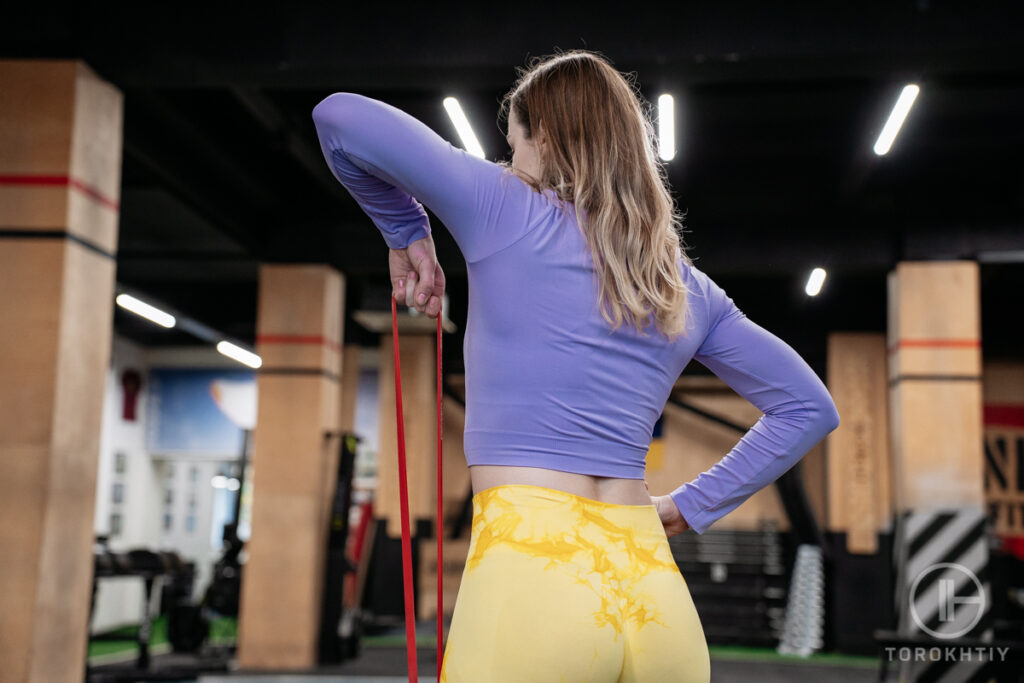
1. Durability
Resistance band can’t last forever: it can split apart because it’s improperly stored. Choose bands that are made of durable and high-quality material to promote its longevity over time and that will withstand different shoulder mobility exercises with bands. Keep in mind that a thicker band is usually more durable.
2. Usability
Select resistance bands that come with color coding to determine their strength. Also, opt for those bands that are suitable for a wide range of exercises.
3. Proper Tension, Stretch & Weight Variety
Usually, resistance bands come in bundles, thus consider bands that provide a variety of weight options. Look at resistance bands with good tension and stretch, since you need to be sure that it can stretch in every range of motion you need without limiting your movements.
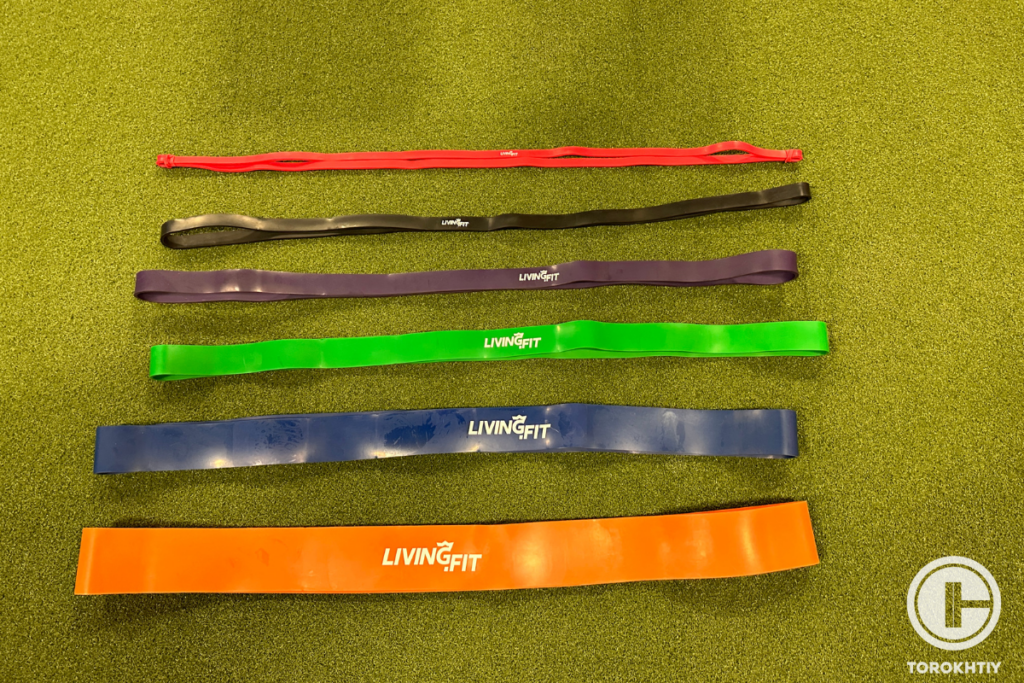
4. Consider the Material
You’ll find bands made from an elastic fabric or rubber latex. The first won’t roll up or slide around during the training. So, this feature makes them ideal for lower body exercises. Latex bands can provide more stretch, making them better for upper body exercises, intensive and explosive movements, joint stability exercises, and stretching.
Rogue Echo resistance bands
Rogue Echo Resistance Bands are a decent fitness tool we highly recommend for everyone who’s going to take up stretching with them. They are made from durable latex rubber and come in 8 various color-coded resistance ranges:
- Bands of 0-2 level offer light resistance for general conditioning and shoulder rehab exercises with bands;
- 3-4 levels provide moderate resistance suitable for banded bench presses and squats, as well as for more intense mobility workouts;
- 5-7 levels give maximum resistance and fit advanced, high-level athletes.

Rogue bands come in the same 41” length, featuring unique Rogue branding on the surface. It’s possible to order the bundle or a separate band that is best suited to your needs.
FAQ
How Do You Stretch Your Rotator Cuff With a Band?
To stretch your rotator cuff you can try to perform the following resistance band shoulder stretches: shoulder external rotation, band pull-apart, horizontal arm extension, bent over row, etc. These exercises engage the arm and core greatly by promoting shoulder mobility.
Can Resistance Bands Help Shoulder Pain?
Yes, resistance bands can eliminate shoulder pain as this is a great fitness equipment that allows you to strengthen your shoulder muscles, also promoting its rehabilitation. Although, unlike free weights, bands don’t require using the full range of motion.
Conclusion
Being highly versatile, resistance bands allow to work out any muscle anywhere, namely performing band shoulder stretches. This tool helps to build strength in the shoulders by providing proper tension that your muscles have to work to resist, making any exercise modifiable.
Have questions about how to integrate more resistance in a controlled way, applying gentle pressure to your shoulders? Ask us more about shoulder stretches with bands in the comments below to assist your body build coordination while exercising.
Also Read:
- Bench Press With Resistance Bands
- Assisted Pull Ups With Resistance Bands
- Resistance Band Squats
- Resistance Band Tricep Workout
- Resistance Band Chest Exercises
- Resistance Bands vs Weights
- Resistance Band Lat Pull Down
- Resistance Bands Guide
- Benefits of Resistance Band Training
References:
- Mi-Kyoung Kim, Jung Chul Lee, Kyung-Tae Yoo. “The effects of shoulder stabilization exercises and pectoralis minor stretching on balance and maximal shoulder muscle strength of healthy young adults with round shoulder posture”, Journal of Physical Therapy Science, No. 30(3), (2018): 373–380.
- Minjoon Kim, Hironobu Kuruma, Chirathip Thawisuk. “The use of elastic band exercise as a physical therapy intervention for improving shoulder function in older adults: a scoping review”, No.17(5), (2021): 313–318.
- Jared K. Powell, Jeremy Lewis, Ben Schram. “Is exercise therapy the right treatment for rotator cuff-related shoulder pain? Uncertainties, theory, and practice”, Wiley Online Library, Musculoskeletal Care, No.22(2), 2024.
- “Causes of Shoulder Pain and Treatment Options. Everything You Need to Know About Shoulder Pain”, https://www.verywellhealth.com/shoulder-pain-2548793
- Rachel C. Seguin, Alan C. Cudlip, and Michael W. R. Holmes. “The Efficacy of Upper-Extremity Elastic Resistance Training on Shoulder Strength and Performance: A Systematic Review”, Sports (Basel), No.10(2), (2022): 24.
- Photos made by Torokhtiy Media Team.
Why Trust Us?
With over 20 years in Olympic weightlifting, strength training, nutrition coaching, and general fitness our team does its best to provide the audience with ultimate support and meet the needs and requirements of advanced athletes and professional lifters, as well as people who strive to open new opportunities and develop their physical capabilities with us.
By trusting the recommendations of our certified experts in coaching, nutrition, and sports training programming, as well as scientific consultants, and physiotherapists, we provide you with thorough, well-considered, and scientifically proven content. All the information given in the articles concerning workout programming, separate exercises, and athletic performance, in general, is based on verified data.
The product testing process is described in more detail here.
Author: Zinaida Bondarenko
Coach, Physiotherapist
Physical rehabilitation experience: 10 years
Zinaida was a member of the national team of Ukraine in rhythmic gymnastics, accumulating 15 years of professional sports experience. She holds certifications in functional training, rehabilitation, kinesiotherapy, specializing in working with athletes across various domains: recovery, rehabilitation, functional and mobility training, General Physical Preparedness (GPP), as well as injury prevention through specific program design. Moreover, she focuses on athlete and coach education to enhance performance and prevent injuries.



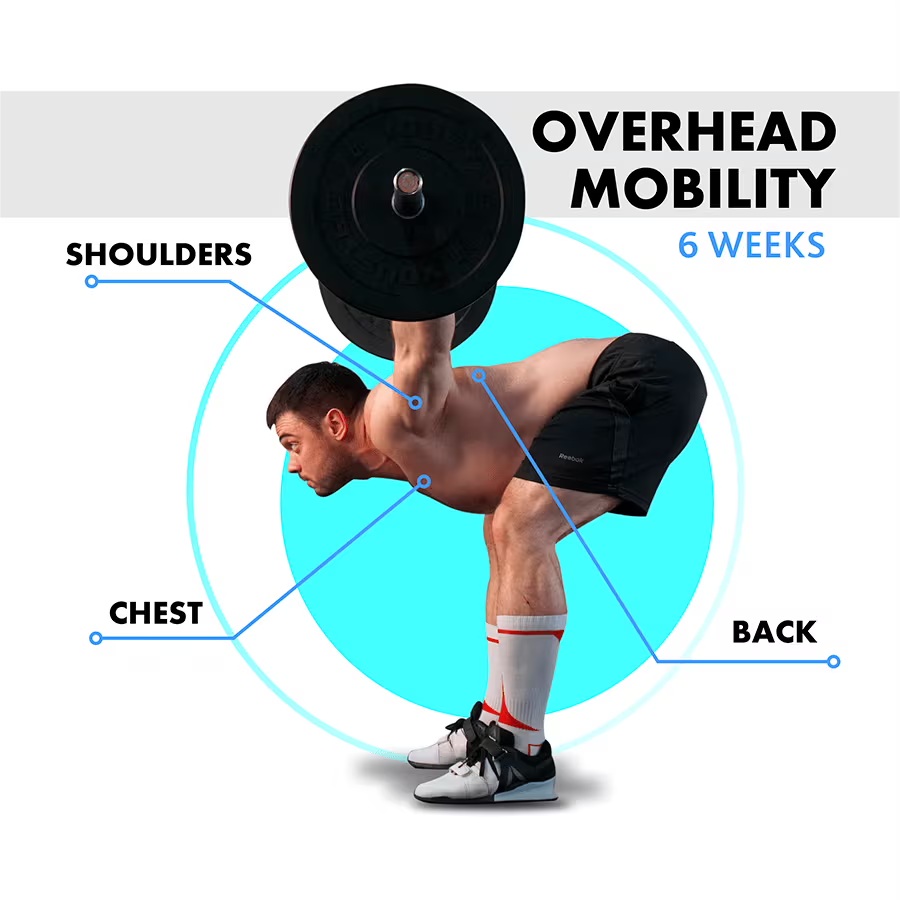
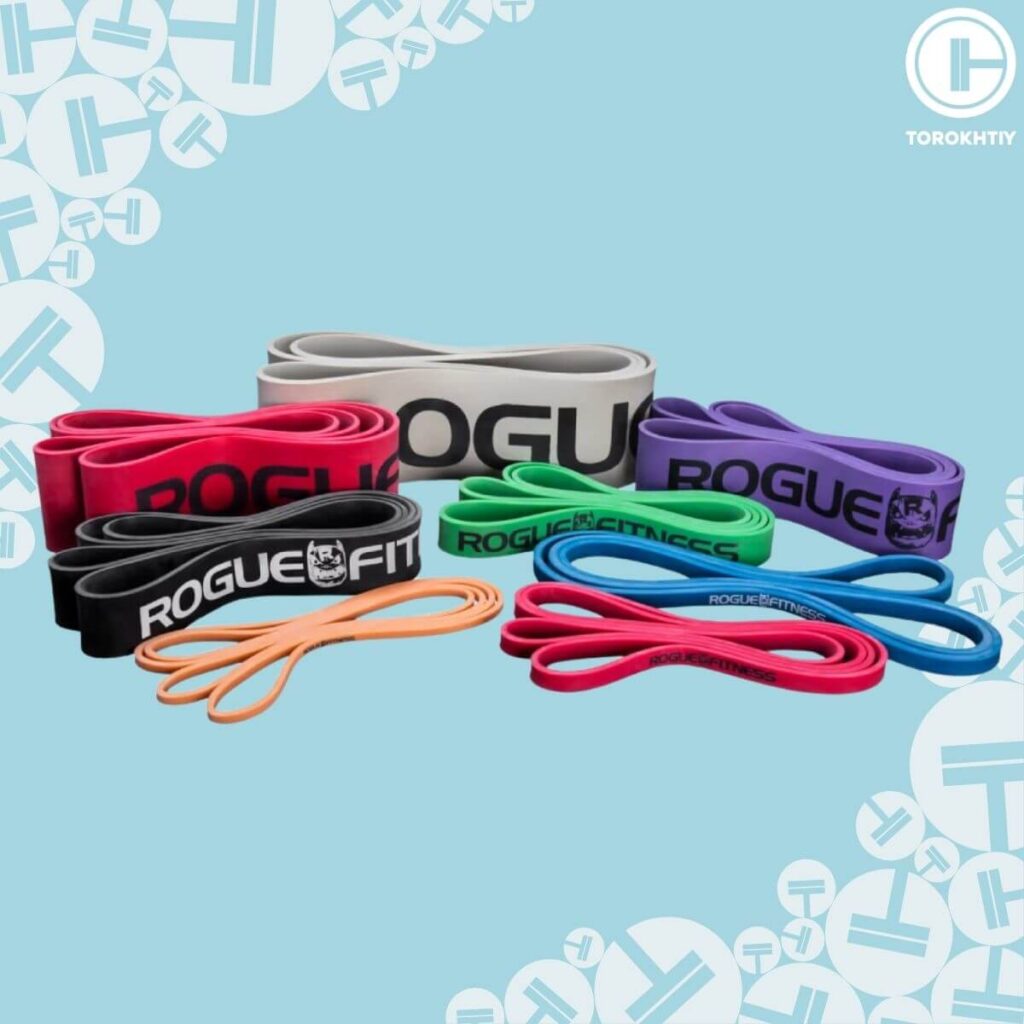
Still have questions after reading our article? Unlock your full potential by engaging with our experts and community! Don’t hesitate — leave a comment below and Zinaida Bondarenko will provide a personalized answer and insights to help you reach your goals.